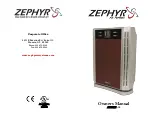
JOHNSON CONTROLS
56
FORM 100.50-NOM6
ISSUE DATE: 8/07/2017
SECTION 3 – START-UP
Gas Heat Models
Pre-Start Checks
When starting up these units, it is imperative that ALL
gas fittings within the unit (in addition to the field in-
stalled gas connections) are leak checked with a soap
solution as part of the unit commissioning process. The
heat section must be fired when checking the joints on
the manifold side of the gas valve. If any leaks are de-
tected, the leaks must be repaired immediately and all
joints rechecked.
Verify wiring inside the burner compartment to insure
the wiring/terminals are tight and securely connected
to the components, such as the ignition control, flame
sensor, gas valve, rollout switches and igniter.
The gas heat start up sequence begins with a 30 sec-
ond prepurge. The next step in the sequence is the clo-
sure of the air proving switch. The heat section has a
combustion air-proving switch. This switch must close
before the ignition sequence can initiate. If the air-
proving switch is closed after the 30 second prepurge
the ignition control will energize the spark igniter and
open the gas valve.
The furnace ignition control uses flame rectification as
verification of burner operation. The minimum allow-
able flame current for operation is 0.7 dc microamps.
If the furnace ignition control does not prove flame in
7 seconds, it will turn off the spark signal and close the
gas valve. It will wait 30 seconds and then initiate a
second ignition sequence. If flame is not proven during
the second 7 second trial for ignition the control will
turn off the spark signal, close the gas valve, wait 30
seconds and initiate a third ignition sequence. If flame
rectification is not proven on the third try, the ignition
control will lock out.
The heat section has two roll out switches mounted
above the burners. The purpose of the roll out switch
is to protect the gas heat section from flame roll out,
flame burning outside the heat exchanger. A restriction
in the heat exchanger or breach in the flue passages
could result in a roll out situation. The roll out switch
is a manual reset device.
The unit has two high temperature limit switches. One
located at the heat exchanger vestibule panel and the
other located in the area of the heat exchanger return
bend. These limits are automatic reset devices. If the
limit opens the ignition control will de-energize the gas
valve. On staged gas heat, as soon as the limit closes
the ignition control will reinitiate the ignition sequence.
The control circuit is tested in the factory to insure that
all of these steps are followed, however, natural gas
is not actually introduced to the system in the plant;
nitrogen is used in its place.
Post Start Checks
When a signal is received at the gas heat control mod-
ule from the Unit Controller, verify:
•
Combustion blower starts and runs for 30 seconds
before the spark is initiated.
•
Spark igniter sparks.
•
Gas valve opens.
•
Burners light from right to left, in a 2.5 second
time frame; that each one lights in sequential or-
der from right to left; and establishes stable flame
immediately upon ignition.
•
Check for gas leaks in the unit piping as well as
the supply piping.
•
Check for correct manifold gas pressures.
See
“Manifold Gas Pressure Adjustment” in this Sec-
tion.
•
Check the supply pressure. It must be within the
limitations shown in
ply pressure should be checked with all gas appli-
ances in the building at full fire. At no time should
the standby gas pressure exceed 13.5" WC, nor
the operating pressure drop below 4.5" WC for
natural gas or 11.0" WC for propane. If the gas
pressure is outside these limits, contact the install-
ing mechanical contractor for corrective action.
• The flame is stable, with flame present only at the
end of the burner, no burning is occurring inside
the burner. There should be little yellow tipping
of the flame.
• There may be some smoke through the flue, due
to tooling oil burning off of the heat exchanger
tubing.
MANIFOLD PRESSURE - STAGED GAS HEAT
TABLE 23 -
LOW FIRE / HIGH FIRE PRESSURES
TYPE OF
GAS
LINE PRESSURE
MANIFOLD
PRESSURE
MIN
MAX
LOW
FIRE +/-
0.3 “WC
HIGH
FIRE +/-
0.3 “WC
NATURAL
4.5 “WC 13.5 “WC 1.2 “WC 3.5 “WC
PROPANE
11.0 “WC 13.5 “WC 4.2 “WC
10.0”WC
















































